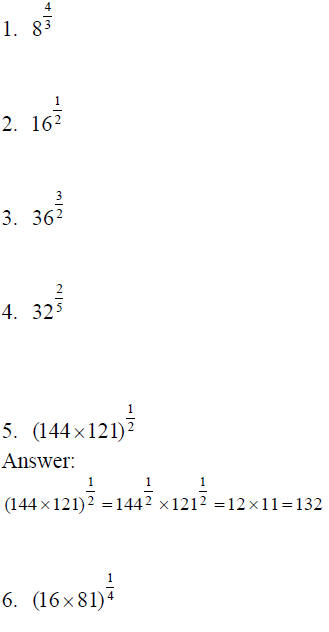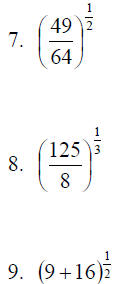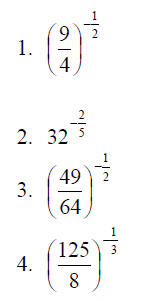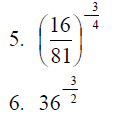Worksheet on rational exponents
Recall that for a rational exponent, the numerator means
the power and the denominator means the root.
So, for example: means
means
a) The cube root of 27 squared, or
b) The square of the cube root of twenty-seven.
a) 27 squared is  , and the cube root of 729
(sometimes written
, and the cube root of 729
(sometimes written  ) is 9, which you find
either using the calculator or by realizing that
) is 9, which you find
either using the calculator or by realizing that

b) The cube root of 27 is 3 (because  ), and
), and
 .
.
In either case we see that
 , although taking the root first is usually
easier if for no other reason than the numbers are smaller.
, although taking the root first is usually
easier if for no other reason than the numbers are smaller.
Compute the following numbers:


Here you must first add, then take the square root.

Here you take the square roots first, then add.
11. Which answer is bigger, the sum of the square roots (#10) or the square root of the sum (#9)? Why?
To annoy you further, we can also have negative exponents as well as positive ones. This is not such a big deal if we remember that a negative
exponent just means the reciprocal. For example:
 looks bad, but if we tease out the meaning
it is comprehensible. The exponent has three parts:
looks bad, but if we tease out the meaning
it is comprehensible. The exponent has three parts:
a) a minus sign,
b) a 2 in the denominator
c) a 3 in the numerator. In turn they mean
a) the reciprocal, b) the square root, and c) the cube (the third power).
Taking care of these, one at a time we get:
 (taking the reciprocal
gets rid of the pesky
(taking the reciprocal
gets rid of the pesky
minus sign in the exponent)
 (taking the square root gets rid of the 2 in
the denominator, and finally
(taking the square root gets rid of the 2 in
the denominator, and finally
 Not so bad.
Not so bad.
Compute:



